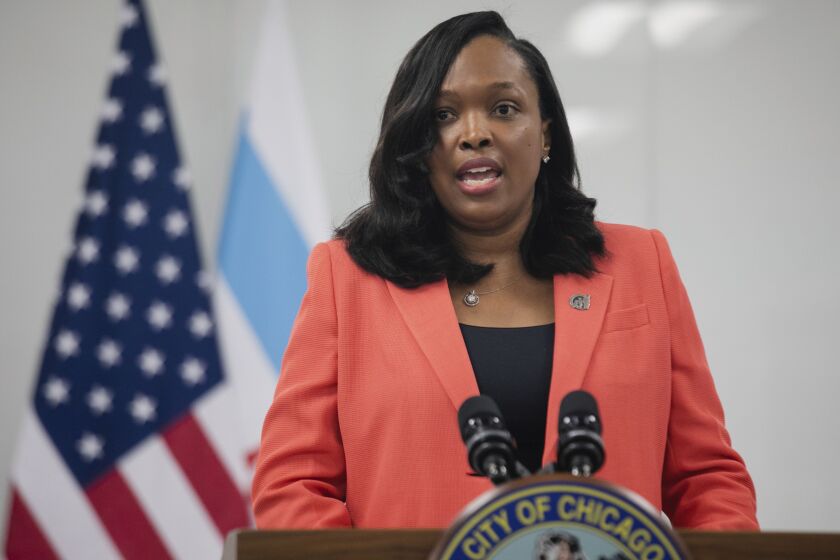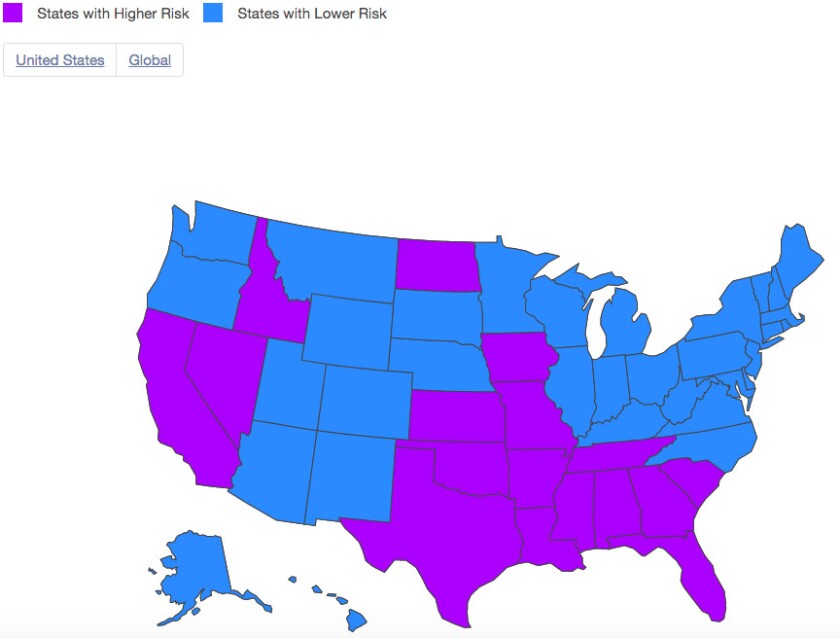Illinois’ coronavirus testing positivity rate inched up again Tuesday with the latest 1,740 cases confirmed statewide, but it’s not the same all over the state.
In Chicago, the rate has remained level at 5%, while suburban Cook County has held steady at 6.1%.
Here are the Tuesday coronavirus stories that you need to know.
News
8:55 p.m. CPS unveils framework for remote learning
Three weeks before fully remote classes are set to begin, Chicago Public Schools on Tuesday released a framework detailing how much time students will be expected to spend in front of a computer every day.
Students in pre-K will receive an hour of real-time instruction with another 90 minutes of learning activities.
Kindergartners, first- and second-graders will have three hours each of instruction and learning activities. Students in third through fifth grade will see three hours and 25 minutes of instruction and two hours and 25 minutes of activities.
In sixth through eighth grade, students will have three hours and 50 minutes of instruction with two hours and 10 minutes of learning activities.
Since their schedules are more varied, high school students will have 80% of their day filled with instruction with the remaining 20% set aside for learning activities.
Read the full story from the Sun-Times staff here.
6:46 p.m. Lightfoot warns of layoffs and furloughs without revenue replacement money from Congress
Saddled with a shortfall that’s $700 million and growing, Mayor Lori Lightfoot said Tuesday she will have no choice but to order employee “layoffs and furloughs” without another round of stimulus money to replace revenue lost during the coronavirus pandemic.
Lightfoot has said repeatedly that raising property taxes is her last resort and layoffs and furloughs are next to last. She has called previous rounds of furloughs demoralizing to city workers.
But, during a panel discussion Tuesday at the virtual Democratic National Convention sponsored by the Center for American Progress Action Fund, the mayor said she’s running out of options to avoid that painful choice.
“If we don’t get [revenue replacement] help from the federal government, we have nothing but bad choices, including looking at layoffs and looking at furloughs,” Lightfoot said.
“This is not the time for government to be putting people into an uncertain economy. We need to make sure that we do everything that we can — that we’re prudent fiduciaries of taxpayer dollars. But the last thing that we should be doing is putting people into the unemployment ranks because we can’t get help from the federal government for this once-in-a-lifetime economic crisis.”
Read the full story from City Hall reporter Fran Spielman here.
3:28 p.m. Illinois reports 1,740 new COVID-19 cases —and highest daily rate of positive test results in two and half months
Illinois’ coronavirus testing positivity rate inched up again Tuesday with the latest 1,740 cases confirmed statewide.
Those new cases were diagnosed among 34,175 tests, or about 5.1% of them — the highest positivity rate for a single day in Illinois in more than 10 weeks.
The state hadn’t cracked 5% since June 5, when 6.1% of COVID-19 tests results came back positive.
That raises Illinois’ seven-day testing positivity rate over the last week to 4.3%, a number that has crawled up from 2.5% on July 7.
Health officials say that rate indicates how rapidly the virus is spreading. Near the height of the pandemic in mid-May, it soared close to 17% across Illinois.
Read the full story from reporter Mitchell Armentrout here.
2:34 p.m. Wisconsin, Nebraska removed from Chicago’s coronavirus travel quarantine list
Officials announced Tuesday that Wisconsin and Nebraska have been dropped from the city’s COVID-19 quarantine list, though travelers to Chicago from 19 other states and Puerto Rico must still isolate for 14 days.
That includes visitors from Iowa and Kansas, which were both added back to the list this week, Chicago Department of Public Health Commissioner Dr. Allison Arwady said during a City Hall news conference.
Workers deemed essential are exempt from the order, though Arwady noted they must “limit their activities to work-related activities [and] avoid public spaces as much as possible.”
Arizona and North Carolina also could be removed next week if the states can remain below the threshold of 15 daily cases per 100,000 residents for a second straight week, Arwady said. The list is updated every Tuesday, with changes taking effect the following Friday.
Read the full story from reporter Tom Schuba here.
2 p.m. Iowa, Missouri marked ‘high risk’ states on Illinois travel map
The Illinois Department of Public Health Monday unveiled a new travel map that identifies states and countries with an increased risk of contracting the coronavirus.
“It’s meant to serve as a resource for individuals to make the best decisions for themselves, for their loved ones or their community, when planning travel — whether work-related or for leisure,” Gov. J.B. Pritzker said.
Places with an average daily case rate of 15 cases per 100,000 people or greater are designated as “higher risk” on the state’s map and shaded purple. Those with a lower risk, including Illinois, are colored blue.
Health officials urge people to avoid travel when sick and to follow the basic guidelines to lessen the possibility of contracting the virus, including wearing a mask, washing hands frequently and practicing social distancing.
12:31 p.m. Navy Pier to close until next spring due to pandemic hurting attendance
With attendance down to a trickle due to the pandemic, officials at Chicago’s Navy Pier said Tuesday the lakefront attraction will close Sept. 8 and will not reopen until next spring.
The decision means more than 70 local businesses that operate at the pier must close. Major attractions such as the Ferris wheel and the Chicago Children’s Museum already are closed.
Navy Pier CEO Marilynn Gardner said the attraction is facing a $20 million deficit this year because of lost business due to COVID-19. The pier closed March 16 and reopened June 10 but has seen summer attendance at less than 20% of normal rates.
“While this was a very difficult decision for the organization, it was a necessary one to proactively ensure the long-term success of one of Chicago’s most treasured and important civic institutions and the communities it serves,” Gardner said.
8:14 a.m. Pizza Hut closing 300 stores to focus on smaller spaces better for COVID-safe pickups
Up to 300 Pizza Hut restaurants will be closed, most of them dine-in locations not well suited for carryout and delivery at a time when millions of people are sheltering and eating at home.
Pizza sales have exploded during the pandemic. Domino’s last month reported a 30% spike in quarterly profits. On Monday it said that it was hiring more than 20,000 people to handle surging orders.
Franchisee NPC International said Monday in documents filed in bankruptcy court that it had come to an agreement with Pizza Hut to close hundreds of locations. The Leawood, Kansas, company filed for bankruptcy protection last month.
NPC owns 1,225 Pizza Huts and 385 Wendy’s restaurants in 27 states. There are 6,700 Pizza Hut restaurants in the U.S.
In its filing, NPC said that closing stores not designed for pick-up or delivery will allow it to invest in smaller stores that can better handle online orders.
New Cases
- State health officials on Monday announced 1,773 new coronavirus cases and 12 additional deaths.
- The preliminary seven-day statewide positivity rate from August 10 through August 16 is 4.2% — a slight uptick from a week ago when the positivity rate stood at 4.1%.
Analysis & Commentary
8:17 a.m. COVID-19 makes clear the need for private and public investment in local water systems
It costs money to make the infrastructure investments needed to ensure people have clean, safe and healthy water. So, it makes sense that water rates are increasing — both for municipally run systems and for those run by water companies — as necessary investments from upgrading treatment plants to replacing aging water mains are made.
As rates increase to support clean drinking water, there are significant, valid concerns around water affordability. One driver of rates are wholesale water costs. For example, the cost of Lake Michigan water purchased from the City of Chicago, which water companies pass through in rates without any markup, has more than doubled over the past decade.
Concerns about affordability have led some municipalities to delay necessary investments for years or even decades. Deferring necessary investment keeps rates low but the resulting failing water systems deliver unsafe water and put public health in jeopardy.







